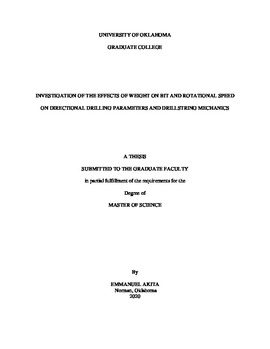| dc.description.abstract | To increase efficiency by optimization, automation has become synonymous with increased drilling efficiency. The oil and gas industry has slowly been adopting automation and process control to improve safety, increase efficiency and reduce downtime on drilling rigs. One cannot properly automate a process without fully understanding and properly modeling the said process. Knowing the output of the process at a specific input helps engineers design the system constraints for automation.
Advances have indeed been made in hydraulics, bit design, tubular strength, downhole sensors, and mud motors. Optimization of efficiency has been studied extensively by several researchers. Finnie and Bailey, Dykstra et al., Jogi et al., Bailey et al., Patil and Teodoriu, among others have developed models and lab scaled experiments to this effect. Typical drillstrings in drilling are too long to allow for accurate surface tracking of downhole vibrations. It is thus imperative to gain a deeper understanding of how surface parameters affect downhole vibrations on a lab-scale at the different weight on bit (WOB) and rotational speeds, especially as applied to directional drilling. For downhole vibrations, there are three modes that come into play during drilling. These are torsional, lateral and axial (Sotomayor et al., 1997, Patil and Teodoriu 2013).
Axial vibrations cause what is known as “bit bouncing”, a phenomenon in which the bit continuously touches and separates itself from the bottom hole. This is usually seen in vertical wells. It could show on the surface as shaking of the top drive or Kelly and fluctuations in WOB values. Mitigation of this is usually done through reducing the WOB and the increasing of revolutions per minute (RPM), changing the bit design as well as the option to include a shock sub in the BHA (Ashley et al., 2001).
Lateral vibrations cause what is known as “whirling”, a phenomenon where the borehole and the drill pipe repeatedly collide in intermittent shock patterns. In this scenario, the drill bit and/or the BHA undergo an eccentric rotation around the wellbore instead of its rotating center. BHA whirling can be recognized at the surface because it usually induces other types of vibration problems such as bit bouncing. Whirling usually happens when there isn’t a stabilizer on the BHA or there isn’t enough lubrication in the borehole while drilling (Ashley et al., 2001).
Finally, torsional vibrations cause what is known as “stick-slip”. In this vibration mode, the bit stops intermittently, causing the string to torque up. This occurs because the torque differs from the downhole toque. After torquing up, there is a release of force in a spring motion when the torque is sufficiently high, spinning free back and forward until it reaches an equilibrium point, or it continues its vibration. (Tucker and Wang, 1999, Omojuwa, et al., 2011). This drilling dysfunction is characterized by large oscillations of the bit rpm (Pavone and Desplans, 1994).
Deviated wells with high angles usually induce this problem, “…when aggressive PDC bits are used and in environments where the BHA to wellbore friction is high” (Ashley, et al., 2001). This dysfunction usually presents itself in fluctuating surface torque and rpm readings. Left unchecked, this could lead to damage of BHA and removal of cutters from PDC bits and teeth from roller cone bits. Typical ways of mitigating this is to reduce WOB and RPM and using roller reamers or increasing mud lubricity to reduce well friction (Ashley, et al., 2001).
These vibration problems usually lead to BHA failure, bit failure, reduce the rate of penetration (ROP) significantly, cause damage to the downhole sensors, destroy bit cutters and BHA components, and induce borehole instability. Axial and lateral vibrations are usually recognized using specialized downhole tools such as MWD. They can be mitigated by stopping momentarily drilling operations or reducing WOB and increasing RPM (Ashley, et al., 2001).
All these drilling vibrations are always present in drilling operations, but they only become a problem when the oscillations in any axis, thus lateral, axial and torsional, come close to the natural frequencies of the system, thus reaching resonance. A summary of the frequencies at which these vibrations become an observable problem is presented by Esmaeili et al. (2012) from field measurements presented in Macpherson et al. (1993).
This study is conducted to thus add to the current understanding of optimization and efficiency, by specifically considering lab-scale directional drilling. An experimental and simulation setup is utilized to investigate the factors affecting drillstring vibrations, response torque, and ROP, and calculated mechanical specific energy.
The main objectives are as follows:
• To explore the automation system utilized for studying lab-scale directional drilling and the novel technique of directional BHA design.
• To use an experimental setup to understand how surface parameters such as WOB and rotational speed affect response torque ROP, and by extension, calculated mechanical specific energy for vertical wells.
• To compare drilling results for vertical wells drilled from a rotating drill bit, and a novel BHA tool.
• To use an experimental setup to understand how surface parameters such as WOB and rotational speed affect response torque ROP, inclination build and by extension, calculated mechanical specific energy for directional wells.
• To use an FEM simulation of the experimental test setup and modal analysis to understand the effect of drillstring vibrations on vertical drilling.
• To use an FEM simulation of the experimental test setup and modal analysis to understand the effect of drillstring vibrations on directional drilling.
A deeper understanding of drilling factors will help to mitigate vibrations. Several models have been put forth to this end, however, understanding of said factors in directional drilling is lacking. This research project focusses on investigating controllable surface parameters and their effect on BHA vibrations. | en_US |

